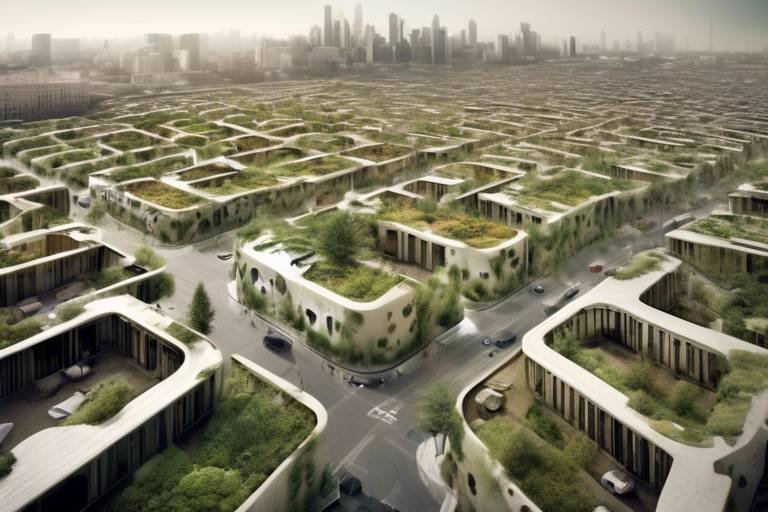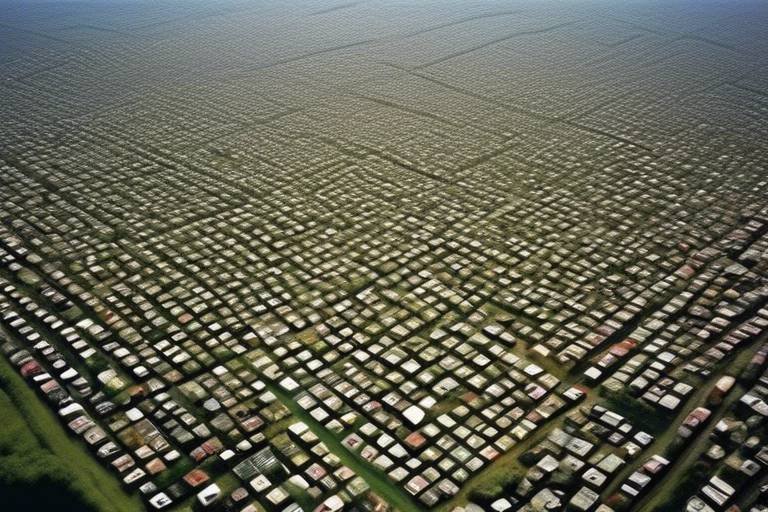The Role of Smart Grids in Urban Energy Consumption
In today's rapidly urbanizing world, the demand for energy is soaring, and cities are at the forefront of this challenge. As urban populations grow, the traditional energy systems struggle to keep up, leading to inefficiencies and increased carbon footprints. Enter smart grids—a revolutionary approach to energy management that integrates digital technology into our existing electrical infrastructure. But what exactly are smart grids, and how do they play a pivotal role in managing urban energy consumption? This article will dive deep into the significance of smart grids, exploring their benefits, challenges, and future prospects in enhancing energy efficiency and sustainability in our cities.
Smart grids represent a significant leap forward from conventional electricity networks. By incorporating digital technology, they enable real-time communication and data exchange between energy providers and consumers. Imagine a network where every light bulb, appliance, and electric vehicle can communicate its energy needs and status—this is the essence of smart grids. At their core, smart grids consist of several fundamental components:
- Advanced Metering Infrastructure (AMI): Smart meters that provide real-time data on energy consumption.
- Communication Networks: Systems that facilitate data exchange between utilities and consumers.
- Distributed Energy Resources (DER): Integration of renewable energy sources like solar and wind.
- Energy Management Systems: Tools that optimize energy use and enhance operational efficiency.
These components work together to create a more responsive and efficient energy ecosystem, ultimately leading to better management of urban energy consumption.
So, what makes smart grids so beneficial for urban energy management? The advantages are plentiful, ranging from improved energy efficiency to enhanced reliability and reduced operational costs. Let's break down some of the key benefits:
One of the standout advantages of smart grids is their ability to optimize energy use. With technologies such as smart meters and real-time monitoring, consumers can track their energy consumption patterns and adjust their usage accordingly. This leads to significant reductions in energy waste. For instance, smart appliances can communicate with the grid to operate during off-peak hours, when energy is cheaper and more abundant. Imagine a world where your refrigerator knows when to run its compressor based on energy prices—this is not just a dream; it’s a reality made possible by smart grids.
Another critical aspect of smart grids is their support for demand response programs. These initiatives empower consumers to adjust their energy usage during peak demand times, alleviating stress on the grid. For example, during a hot summer day, when air conditioning usage spikes, consumers can receive alerts to reduce their consumption, helping to maintain grid stability and lower energy costs. This not only benefits the individual consumer but also contributes to overall energy efficiency.
Smart grids also facilitate the seamless integration of renewable energy sources into the energy mix. With the growing emphasis on sustainability, cities are increasingly turning to solar, wind, and other renewable sources. Smart grids enable these resources to be effectively managed and utilized, reducing dependency on fossil fuels and lowering carbon footprints. By providing real-time data on energy generation and consumption, smart grids make it easier for cities to transition to a more sustainable energy future.
Despite the numerous benefits, the implementation of smart grids is not without its challenges. High initial costs and cybersecurity risks are significant obstacles that need to be addressed. The transition to smart grids requires substantial investment in infrastructure and technology, which can be a daunting prospect for many municipalities. Additionally, as smart grids rely heavily on data and connectivity, they are vulnerable to cyber threats. Ensuring robust security measures and developing cost-effective solutions will be crucial for the widespread adoption of smart grids.
The future of smart grids looks bright, with continuous advancements in technology and supportive policy frameworks. Emerging trends such as the integration of artificial intelligence and machine learning are set to enhance the capabilities of smart grids even further. These technologies can analyze vast amounts of data to optimize energy management, predict demand patterns, and improve grid reliability.
As technology evolves, so too does the potential of smart grids. Innovations like blockchain for energy transactions and advanced energy storage solutions are on the horizon, promising to revolutionize urban energy systems. The ability to store energy generated from renewable sources and release it when needed will be a game-changer for cities striving for sustainability.
Supportive policies and regulations play a crucial role in fostering smart grid development. Government initiatives aimed at promoting smart grid adoption and investment can accelerate the transition to more efficient energy systems. By providing incentives for renewable energy integration and funding for infrastructure upgrades, policymakers can help pave the way for a smarter, more sustainable energy future.
- What are smart grids? Smart grids are advanced electrical systems that use digital technology to enhance the efficiency and reliability of electricity distribution.
- How do smart grids benefit urban areas? They improve energy efficiency, facilitate renewable energy integration, and support demand response programs, leading to reduced costs and environmental impact.
- What challenges do smart grids face? Key challenges include high initial costs, cybersecurity risks, and the need for substantial infrastructure upgrades.
- What is the future of smart grids? The future looks promising with advancements in technology such as AI and supportive government policies driving their adoption.

Understanding Smart Grids
Smart grids are revolutionizing the way we think about energy distribution and consumption in urban environments. Imagine a traditional electrical grid, which is like a one-way street where electricity flows from power plants to homes and businesses without much interaction. Now, picture a smart grid as a bustling two-way highway, filled with real-time communication and data exchange between various entities. This transformation is made possible by the integration of digital technology into the existing electricity networks, enabling a more responsive and efficient energy system.
At the core of smart grids are several fundamental components that work together to enhance the overall energy experience. These include:
- Advanced Metering Infrastructure (AMI): This technology allows for real-time data collection and monitoring of energy usage, giving consumers insights into their consumption patterns.
- Distribution Automation: Smart grids utilize automated systems to manage electricity distribution, which helps in quickly identifying and resolving outages.
- Smart Sensors: These devices collect data on energy flow and system performance, enabling proactive maintenance and management of the grid.
- Communication Networks: Robust communication systems are essential for transmitting data between consumers, utilities, and energy sources.
One of the standout features of smart grids is their ability to facilitate real-time communication. This means that utilities can monitor energy demand and supply dynamically, allowing for better decision-making and resource allocation. For instance, during peak hours, smart grids can automatically adjust the distribution of electricity to prevent overloads and outages, akin to a conductor guiding an orchestra to ensure harmony.
Moreover, smart grids are designed to accommodate a variety of energy sources, including traditional fossil fuels and renewable energy options like solar and wind. This flexibility is crucial as cities strive to meet their sustainability goals. By integrating renewable energy, smart grids not only help reduce carbon footprints but also enhance energy security by diversifying the energy supply.
In conclusion, understanding smart grids is essential for grasping the future of urban energy consumption. They represent a significant leap towards a more sustainable and efficient energy landscape, where technology and innovation play pivotal roles. As cities continue to grow, the role of smart grids will become increasingly vital in managing energy consumption effectively.

Benefits of Smart Grids
Smart grids are revolutionizing the way we think about energy consumption in urban settings. They are not just a technological upgrade; they represent a fundamental shift in how energy is managed, distributed, and consumed. One of the most striking benefits of smart grids is their ability to enhance energy efficiency. By utilizing advanced technologies such as smart meters and real-time data analytics, smart grids allow both consumers and utility providers to monitor and manage energy usage more effectively. This leads to a significant reduction in energy waste, which is crucial in today's world where energy conservation is paramount.
Moreover, smart grids improve the reliability of energy supply. Traditional grids are often plagued by outages and inefficiencies, but smart grids can quickly detect and isolate faults, minimizing downtime. This reliability is particularly important for urban areas where energy demands fluctuate dramatically throughout the day. With smart grids, cities can ensure that energy is consistently available, even during peak usage times.
Another noteworthy advantage is the potential for cost reduction. By optimizing energy distribution and reducing waste, smart grids can lower operational costs for utility providers, which can translate into savings for consumers. For instance, when energy is used more efficiently, the overall demand on the grid decreases, leading to lower prices. Additionally, the integration of renewable energy sources, which smart grids facilitate, can further reduce costs associated with fossil fuels and greenhouse gas emissions.
To illustrate the benefits of smart grids, consider the following table that summarizes key advantages:
| Benefit | Description |
|---|---|
| Energy Efficiency | Reduces energy waste through real-time monitoring and management. |
| Reliability | Improves the stability of energy supply and reduces outages. |
| Cost Reduction | Lowers operational costs for utilities and consumers alike. |
Furthermore, smart grids encourage the adoption of renewable energy sources. As cities strive to meet sustainability goals, integrating solar, wind, and other renewable sources becomes increasingly important. Smart grids not only facilitate this integration but also allow for better management of these variable energy sources. For instance, during sunny days, excess solar energy can be stored or redirected, ensuring that it is utilized effectively rather than wasted. This capability not only supports sustainability but also helps reduce the overall carbon footprint of urban areas.
In addition to these benefits, smart grids play a crucial role in empowering consumers. With access to real-time data about their energy usage, individuals can make informed decisions about their consumption patterns. This transparency encourages energy-saving behaviors, leading to a culture of sustainability within communities. Imagine being able to see how much energy your home uses at any given moment and adjusting your consumption accordingly—this is the power of smart grids.
In conclusion, the benefits of smart grids extend far beyond mere technological advancements. They represent a comprehensive approach to managing urban energy consumption that prioritizes efficiency, reliability, and sustainability. As cities continue to grow and evolve, the role of smart grids in shaping a more energy-conscious future cannot be overstated. Are you ready to embrace this energy revolution?

Energy Efficiency Improvements
One of the primary advantages of smart grids is their remarkable ability to optimize energy use, which is crucial in urban settings where energy demand can quickly spiral out of control. Imagine a bustling city where the lights never dim, and the energy flows seamlessly to where it’s needed most. This is the promise of smart grids. By harnessing advanced technologies, smart grids help reduce energy waste and promote efficiency, leading to a more sustainable future.
At the heart of this optimization are several innovative technologies that work in concert to enhance energy efficiency. For instance, smart meters play a pivotal role, allowing consumers to monitor their energy usage in real-time. This transparency empowers users to make informed decisions about their consumption habits. When people see their energy usage patterns, they are more likely to adjust their habits, leading to significant reductions in unnecessary consumption.
Moreover, smart grids facilitate the implementation of automated demand response (ADR) systems. These systems automatically adjust energy consumption during peak demand periods, ensuring that the grid remains stable while consumers save money. For example, during a hot summer afternoon when air conditioning units are running at full blast, an ADR system can temporarily reduce the power supply to these units, thereby lowering the overall demand on the grid. This not only helps in reducing energy costs for consumers but also minimizes the need for additional power plants, which can be both costly and environmentally detrimental.
Another key feature of smart grids is their ability to integrate renewable energy sources effectively. By utilizing technologies such as solar panels and wind turbines, smart grids can harness clean energy, reducing reliance on fossil fuels. This integration supports sustainability goals and contributes to a significant decrease in carbon footprints. For instance, when solar energy is abundant during the day, smart grids can redirect this energy to power homes and businesses, while storing excess energy for use during nighttime or cloudy days.
In addition to these technologies, smart grids also employ energy storage systems that can capture and store excess energy produced from renewable sources. This stored energy can be released back into the grid when demand peaks, ensuring a consistent supply. The combination of real-time data analytics, renewable energy integration, and storage solutions creates a dynamic and responsive energy system that can adapt to the ever-changing needs of urban environments.
In conclusion, the evolution of energy efficiency improvements through smart grids is not just a technological advancement; it’s a paradigm shift in how we approach energy consumption in urban areas. By embracing these innovations, cities can not only enhance their energy efficiency but also pave the way for a sustainable and resilient future. The integration of smart technologies ensures that energy is used wisely, benefiting both the environment and the economy.
- What is a smart grid? A smart grid is an electricity supply network that uses digital technology to monitor and manage the transport of electricity from all generation sources to meet the varying electricity demands of end-users.
- How do smart grids improve energy efficiency? Smart grids improve energy efficiency by optimizing energy consumption through real-time data, automated demand response systems, and integration of renewable energy sources.
- What are the challenges of implementing smart grids? Some challenges include high initial costs, cybersecurity risks, and the need for regulatory support to facilitate widespread adoption.
- What role do consumers play in smart grid efficiency? Consumers can actively participate by monitoring their energy usage with smart meters and adjusting their consumption patterns based on real-time data.

Demand Response Programs
Demand response programs are an innovative approach to managing energy consumption, particularly during peak demand periods. Imagine a bustling city where everyone is cranking up their air conditioning on a sweltering summer day. This surge in energy use can strain the electrical grid, leading to outages or the need for costly infrastructure upgrades. Demand response programs step in as a strategic solution, allowing consumers to adjust their energy usage in response to grid demands, ultimately helping to balance supply and demand.
These programs are not just beneficial for the energy providers; they also offer significant savings for consumers. By participating in demand response initiatives, households and businesses can receive financial incentives or lower rates for reducing their energy usage during peak times. For instance, if a utility company predicts a high demand period, they may send alerts to participants, prompting them to reduce their energy consumption temporarily. This could mean turning off non-essential appliances or shifting energy-intensive activities to off-peak hours.
To illustrate the impact of demand response programs, let's take a look at a hypothetical scenario:
| Time Period | Normal Energy Usage (kWh) | Reduced Energy Usage (kWh) | Cost Savings |
|---|---|---|---|
| Peak Time (4 PM - 7 PM) | 150 kWh | 100 kWh | $30 |
| Off-Peak Time (10 PM - 6 AM) | 50 kWh | 50 kWh | $0 |
In this example, by reducing their energy usage during peak hours from 150 kWh to 100 kWh, consumers can save $30. This not only helps the grid but also puts money back into the pockets of participants. It’s a win-win situation!
Moreover, demand response programs contribute to a more resilient energy system. By flattening the demand curve, they reduce the need for additional power plants, which can be both costly and environmentally damaging. As cities strive for sustainability, these programs align perfectly with the broader goals of energy efficiency and reduced carbon emissions.
However, it's essential to address some common concerns about demand response programs. Many consumers may worry about the inconvenience of adjusting their energy use. But with advancements in technology, smart appliances can automatically respond to demand response signals, making participation seamless and hassle-free. In essence, consumers can enjoy the benefits of these programs without having to lift a finger.
In summary, demand response programs are a critical component of smart grid technology, offering a practical solution to the challenges of urban energy consumption. By enabling consumers to play an active role in energy management, these initiatives not only enhance grid stability but also pave the way for a more sustainable energy future.
- What are demand response programs? Demand response programs are initiatives that encourage consumers to reduce or shift their energy usage during peak demand times in exchange for financial incentives.
- How do I participate in a demand response program? Participation typically involves signing up with your utility provider, which may offer incentives for reducing energy use during peak periods.
- Are there any downsides to participating? While most consumers find it beneficial, some may worry about the inconvenience of changing their energy habits. However, smart technology can automate many adjustments.
- How do demand response programs benefit the environment? By reducing peak demand, these programs can minimize the need for additional power plants, leading to lower carbon emissions and a more sustainable energy system.

Renewable Energy Integration
In today's world, where climate change is a pressing concern, the integration of renewable energy sources into the smart grid is not just a trend; it's a necessity. Smart grids act as a bridge, connecting various forms of renewable energy—like solar, wind, and hydro—to the traditional electricity network. This integration allows for a more sustainable energy ecosystem, significantly reducing our reliance on fossil fuels. Imagine a city where rooftops are adorned with solar panels, and wind turbines spin gracefully on the outskirts, all feeding clean energy into the grid. This is not just a dream; it's becoming a reality thanks to smart grid technology.
One of the most exciting aspects of renewable energy integration is its potential to reduce carbon footprints. By harnessing the power of the sun and wind, cities can generate electricity with minimal environmental impact. For instance, solar panels can convert sunlight into energy during the day, while wind turbines can generate power even on cloudy days. When these energy sources are connected to a smart grid, they can be monitored and managed in real-time, ensuring that supply meets demand efficiently.
Moreover, smart grids facilitate the use of energy storage systems, which play a vital role in balancing supply and demand. Batteries can store excess energy generated during peak production times, such as sunny afternoons or windy nights, and release it when demand spikes. This capability not only enhances the reliability of renewable energy but also stabilizes the grid, making it less susceptible to outages. The following table illustrates the benefits of integrating different renewable energy sources into a smart grid:
| Renewable Energy Source | Benefits | Challenges |
|---|---|---|
| Solar Energy | Abundant, reduces electricity bills | Intermittent supply, space requirements |
| Wind Energy | Low operating costs, reduces greenhouse gases | Noise, impact on wildlife |
| Hydro Energy | Consistent power supply, high efficiency | Environmental impact, high initial costs |
However, the path to seamless renewable energy integration isn't without its hurdles. Many cities face challenges such as infrastructure limitations and the need for significant investment in technology. Additionally, regulatory frameworks must evolve to support these changes, ensuring that the integration of renewable sources is not only feasible but also efficient. As cities work towards these goals, they can pave the way for a greener, more sustainable future.
As we look ahead, the role of smart grids in renewable energy integration will only become more critical. With ongoing technological advancements and increasing public awareness, the transition to a more sustainable energy landscape is not just possible—it’s inevitable. The synergy between smart grids and renewable energy sources presents an exciting opportunity for cities to transform their energy systems, reduce emissions, and ultimately, create a cleaner planet for future generations.
- What are smart grids? Smart grids are modernized electrical grids that use digital technology to monitor and manage the transport of electricity from all generation sources to meet the varying electricity demands of end users.
- How do smart grids support renewable energy? Smart grids facilitate the integration of renewable energy sources by allowing real-time monitoring and management, optimizing energy distribution, and incorporating energy storage solutions.
- What are the benefits of renewable energy integration? Integrating renewable energy reduces carbon emissions, enhances energy reliability, and promotes energy independence.
- What challenges do smart grids face? Challenges include high initial costs, cybersecurity risks, and the need for updated regulatory frameworks.

Challenges in Implementation
Implementing smart grids is not all sunshine and rainbows; it comes with its own set of challenges that can make even the most enthusiastic advocates pause for thought. One of the **most significant hurdles** is the **high initial cost** associated with upgrading existing infrastructure. Transitioning from traditional grids to smart grids requires substantial investment in technology, installation, and training. According to recent studies, the estimated cost for a full-scale smart grid implementation can range from millions to billions of dollars, depending on the size and scope of the project. This financial burden can deter municipalities and energy providers from pursuing smart grid technologies.
Another pressing challenge is the looming threat of **cybersecurity risks**. As smart grids rely heavily on digital communication and data exchange, they become attractive targets for hackers and cybercriminals. A successful cyberattack could disrupt energy distribution, compromise sensitive consumer data, and even pose risks to public safety. For instance, the **2015 cyberattack on Ukraine's power grid** serves as a stark reminder of the vulnerabilities inherent in modern electricity networks. To mitigate these risks, energy providers must invest in robust cybersecurity measures, which can further inflate costs and complicate implementation.
Moreover, the **integration of diverse energy sources** into smart grids presents another layer of complexity. As cities strive to incorporate renewable energy sources like solar and wind into their energy mix, they must also address issues related to the variability and unpredictability of these resources. This means that energy management systems need to be incredibly sophisticated, capable of balancing supply and demand in real-time while accommodating the fluctuations that come with renewable energy generation.
Furthermore, the lack of **standardization** across different regions and technologies can hinder the interoperability of smart grid systems. Without common standards, different components from various manufacturers may not work seamlessly together, leading to inefficiencies and increased operational challenges. This situation can create a fragmented landscape where energy providers struggle to coordinate efforts, ultimately affecting the reliability of the entire grid.
Lastly, there is a **social aspect** to consider. Public acceptance and awareness of smart grid technology are crucial for its success. Many consumers may not fully understand how smart grids work or the benefits they bring. This lack of understanding can lead to resistance against new technologies, especially if people feel their privacy is being compromised or their energy costs are increasing. Therefore, energy providers must engage in effective communication strategies to educate the public and build trust.
In summary, while the potential benefits of smart grids are immense, the challenges in their implementation cannot be overlooked. From high costs and cybersecurity threats to the complexities of integrating renewable energy and the need for standardization, these obstacles require thoughtful solutions and collaborative efforts among stakeholders. Addressing these challenges head-on will be essential for realizing the full potential of smart grids in urban energy consumption.
- What are smart grids? Smart grids are electricity networks that use digital technology to monitor and manage the transport of electricity from all generation sources to meet the varying electricity demands of end users.
- What are the main benefits of smart grids? Smart grids improve energy efficiency, enhance reliability, reduce operational costs, and support the integration of renewable energy sources.
- What challenges do smart grids face? Key challenges include high initial costs, cybersecurity risks, integration of renewable energy, lack of standardization, and public acceptance.
- How can the public be educated about smart grids? Energy providers can engage in outreach programs, workshops, and digital campaigns to inform and educate consumers about the benefits and functionalities of smart grids.

Future of Smart Grids
The is not just a concept; it’s a rapidly evolving reality that promises to transform urban energy landscapes. With the integration of cutting-edge technologies and supportive government policies, smart grids are set to revolutionize how we consume and manage energy in our cities. Imagine a world where your home can communicate with the power grid, adjusting energy usage based on real-time data. Sounds futuristic, right? But this is precisely what smart grids aim to achieve.
One of the most exciting aspects of smart grids is the role of technological innovations. Advancements in artificial intelligence (AI) and machine learning are enhancing the capabilities of smart grids. These technologies can analyze vast amounts of data to predict energy demand, optimize energy distribution, and even identify potential faults before they become significant issues. For instance, AI algorithms can assess usage patterns and suggest ways for consumers to reduce their energy consumption, making them not just passive users but active participants in energy management.
Moreover, renewable energy sources are becoming increasingly integrated into smart grids, which is a crucial step toward achieving sustainability. As cities strive to meet their carbon reduction targets, the ability to seamlessly incorporate solar, wind, and other renewable energies into the grid becomes essential. Smart grids facilitate this integration by allowing for real-time adjustments based on energy availability and demand. This means that when the sun is shining or the wind is blowing, energy can be harnessed efficiently, reducing reliance on fossil fuels and lowering overall emissions.
However, for smart grids to reach their full potential, policy and regulation play a critical role. Government initiatives aimed at promoting smart grid adoption can provide the necessary financial backing and regulatory framework to encourage investment. This includes incentives for both consumers and utility companies to embrace smart technologies. For example, tax credits for solar panel installations or grants for research into energy efficiency can drive innovation and implementation.
Despite the challenges that lie ahead, the future of smart grids is bright. As cities continue to grow and energy demands increase, the need for a more efficient, reliable, and sustainable energy system becomes ever more pressing. The convergence of technology, policy, and consumer engagement will undoubtedly shape the evolution of urban energy systems, making smart grids a cornerstone of modern infrastructure.
- What are smart grids?
Smart grids are electricity supply networks that use digital technology to monitor and manage the transport of electricity from all generation sources to meet the varying electricity demands of end users. - How do smart grids improve energy efficiency?
They improve energy efficiency by using real-time data and analytics to optimize energy distribution and consumption, reducing waste and ensuring a more balanced load on the grid. - What role do renewable energies play in smart grids?
Smart grids facilitate the integration of renewable energy sources, allowing for a more sustainable energy mix and reducing dependence on fossil fuels. - What challenges do smart grids face?
Key challenges include high initial costs, cybersecurity risks, and the need for regulatory support to encourage widespread adoption.

Technological Innovations
In the rapidly evolving landscape of urban energy management, are playing a pivotal role in enhancing the capabilities of smart grids. These advancements not only improve the efficiency of energy distribution but also empower consumers to make informed decisions about their energy usage. Imagine a world where your energy consumption is optimized in real-time, reducing waste and saving money—this is becoming a reality thanks to cutting-edge technologies.
One of the most exciting developments is the integration of artificial intelligence (AI) and machine learning (ML)
Moreover, the use of Internet of Things (IoT) devices is revolutionizing how energy is monitored and managed. Smart meters, for instance, provide real-time feedback to consumers about their energy usage. This immediate access to data empowers individuals to change their consumption habits, leading to more sustainable energy practices. Picture a household receiving alerts when they exceed their typical energy use; this prompts them to adjust their behavior, thus contributing to overall energy conservation.
Additionally, advancements in energy storage technologies are crucial for supporting renewable energy integration. With the ability to store excess energy generated during peak production times—such as sunny afternoons for solar panels—these technologies ensure that energy is available when demand is high. This capability not only stabilizes the grid but also encourages the use of renewable sources, aligning with global sustainability goals.
To give you a clearer picture of how these technologies come together, consider the following table that outlines key innovations and their impacts:
| Technology | Impact on Smart Grids |
|---|---|
| Artificial Intelligence | Predicts demand, optimizes distribution, reduces costs |
| Machine Learning | Analyzes consumption patterns, enhances efficiency |
| Internet of Things | Real-time monitoring, consumer engagement, data-driven decisions |
| Energy Storage | Balances supply and demand, supports renewables |
As we look to the future, the integration of these technological innovations will only deepen. The synergy between AI, IoT, and advanced energy storage solutions is set to create a more resilient and adaptive energy grid. This evolution will not only empower cities to manage their energy consumption more effectively but also foster a culture of sustainability among consumers. So, the next time you flip a switch, remember that there's a whole world of technology working behind the scenes to ensure that energy is available, reliable, and sustainable.
- What are smart grids? Smart grids are modernized electrical grids that use digital technology to monitor and manage electricity flow from all generation sources to meet the varying electricity demands of end-users.
- How do technological innovations improve smart grids? Innovations such as AI, ML, and IoT enhance the efficiency, reliability, and sustainability of energy management by optimizing energy distribution and empowering consumers with real-time data.
- What is the role of energy storage in smart grids? Energy storage systems help balance supply and demand by storing excess energy generated during low-demand periods and releasing it during peak demand times.

Policy and Regulation
The development and implementation of smart grids are significantly influenced by . These frameworks are essential for creating an environment that encourages investment, innovation, and integration of new technologies. Without the right policies in place, the transition to smart grids could face numerous hurdles, including financial constraints and lack of public support.
Governments around the world are recognizing the importance of smart grids in achieving sustainability goals and enhancing energy security. For instance, many countries have introduced incentive programs aimed at encouraging utilities and consumers to adopt smart technologies. These incentives can take various forms, such as tax credits, grants, or rebates for energy-efficient upgrades. By lowering the financial barriers to entry, these policies can accelerate the adoption of smart grid technologies.
Moreover, regulatory frameworks often dictate how energy markets operate. This includes setting standards for grid interoperability, data privacy, and consumer protections. For example, the Federal Energy Regulatory Commission (FERC) in the United States has established guidelines that promote competition and innovation in the energy sector. This regulatory support is crucial for fostering a marketplace where smart grid solutions can thrive.
However, policy and regulation are not without their challenges. One significant issue is the balancing act between encouraging innovation and ensuring consumer protection. Policymakers must navigate complex questions about data ownership and privacy, especially as smart grids rely heavily on data collection and analysis. Striking the right balance is critical to maintaining public trust and ensuring widespread adoption.
In addition, the rapid pace of technological advancement poses a challenge for regulators. As new technologies emerge, existing regulations may become outdated, hindering progress. To address this, many jurisdictions are adopting a more flexible regulatory approach that allows for adaptive management of energy policies. This means creating regulations that can evolve alongside technological advancements, ensuring that they remain relevant and effective.
Overall, the role of policy and regulation in the development of smart grids cannot be overstated. They serve as the backbone of the energy transition, guiding investments and shaping the future of urban energy systems. As cities continue to grow and face mounting energy challenges, the importance of strong, supportive policies will only increase.
- What are smart grids? Smart grids are electricity networks that use digital technology to monitor and manage the transport of electricity from all generation sources to meet the varying electricity demands of end users.
- How do smart grids improve energy efficiency? Smart grids optimize energy usage through real-time data analytics, enabling better demand response and integration of renewable energy sources.
- What challenges do smart grids face? Key challenges include high initial costs, cybersecurity risks, and the need for updated policies and regulations to support their implementation.
- What role do policies play in smart grid development? Policies create an enabling environment for investment, innovation, and integration of smart grid technologies, while also addressing consumer protection and data privacy concerns.
Frequently Asked Questions
- What is a smart grid?
A smart grid is an advanced electricity network that uses digital technology to monitor and manage the transport of electricity from all generation sources to meet the varying electricity demands of end-users. This integration allows for real-time communication, which enhances the efficiency and reliability of energy distribution.
- How do smart grids improve energy efficiency?
Smart grids enhance energy efficiency by utilizing technologies that optimize energy consumption. They enable better demand response programs, allowing consumers to adjust their usage during peak times, thus reducing waste and lowering energy costs. Additionally, they integrate renewable energy sources more effectively, promoting a sustainable energy ecosystem.
- What are demand response programs?
Demand response programs are initiatives that encourage consumers to modify their electricity usage during peak demand periods. By shifting usage to off-peak times, these programs help alleviate stress on the grid, reduce the need for additional power generation, and ultimately lower energy bills for consumers.
- What challenges do smart grids face?
Despite their many advantages, smart grids encounter several challenges, including high initial setup costs and cybersecurity risks. These obstacles can hinder widespread adoption, but ongoing advancements in technology and regulatory support aim to address these issues and promote a smoother transition to smart grid systems.
- What is the future of smart grids?
The future of smart grids looks bright, with continuous technological innovations such as artificial intelligence and machine learning enhancing their capabilities. Furthermore, supportive policies and regulations from governments play a crucial role in fostering investment and development in smart grid technologies, paving the way for a more sustainable urban energy landscape.
- How do smart grids support renewable energy integration?
Smart grids facilitate the incorporation of renewable energy sources, like solar and wind, into the existing energy infrastructure. By managing and distributing this energy more efficiently, smart grids help reduce carbon footprints and support sustainability goals, making cities greener and more resilient.



















